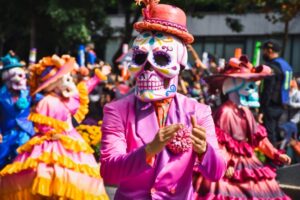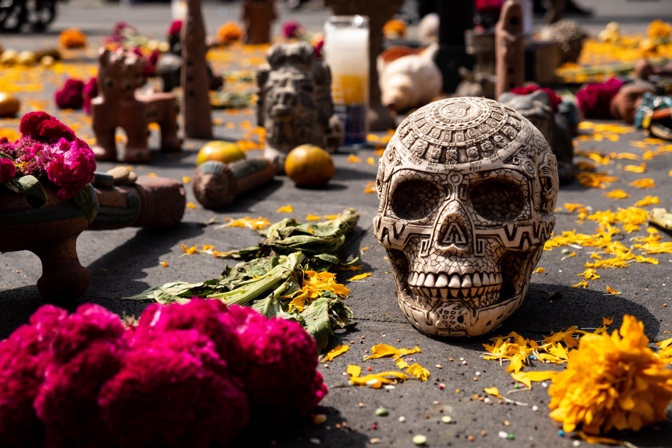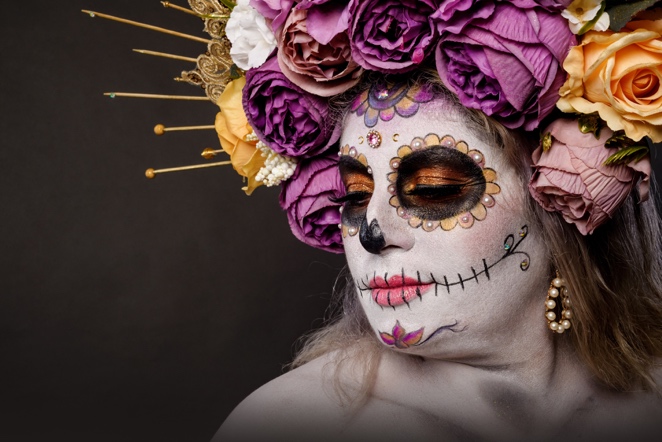Día de los Muertos, or the Day of the Dead, is a lively and culturally rich Mexican holiday celebrated over the first two days of November. It transcends geographical borders and has captivated the world with its colorful and heartfelt traditions. Rooted in indigenous beliefs that were later influenced by Catholicism, this celebration is a unique fusion of spirituality, art, and communal gatherings. Though it has been misunderstood over the years as an extension of Halloween, the rich history and traditions of the holiday separate it as a time to honor the lives of the departed and to commemorate the cycle of life and death.
The roots of Día de los Muertos can be traced back thousands of years to the indigenous populations of Mexico, including Aztec, Toltec, and other Nahua groups. They saw death as a natural phase of life. They believed the deceased would remain with them in memory and spirit then once a year, they could temporarily return to Earth. Thus, they developed rituals and traditions to help guide the spirits of deceased loved ones back to the living during the time of Día de los Muertos.
One of the most prominent aspects of Día de los Muertos is the creation of ofrendas, or altars. These elaborate and vibrant altars are assembled in homes and cemeteries, featuring offerings such as marigold flowers, sugar skulls, pan de muerto, candles, incense, and cherished possessions of the departed. Additionally, people dress up in vibrant attire and commonly wear calavera (skull) masks or face paint, symbolizing the thin line between life and death.
Catholic and European elements were also infused into these practices when Spanish colonization began in the 16th century. Ofrenda offerings expanded to include images of saints, crosses, rosaries, and crucifixes. La Calavera Catrina, originally called La Calavera Garbancera, has also become a main symbol of the holiday but stemmed from a commentary on these outside societal influences. According to the History Channel, “In the early 20th century, the printer and cartoonist José Guadalupe Posada incorporated skeletal figures in his art mocking politicians and commenting on revolutionary politics. His most well-known work, La Calavera Catrina, or Elegant Skull, features a female skeleton adorned with makeup and dressed in fancy clothes. The 1910 etching was intended as a statement about Mexicans adopting European fashions over their own heritage and traditions. La Calavera Catrina was then adopted as one of the most recognizable Day of the Dead icons.” Posada is often credited with the quote, “Todos somos calaveras,” meaning “we are all skeletons.” It points to the idea that underneath all our “manmade trappings,” we are all the same and death leaves no one behind (National Geographic).
Today, many Mexican towns and cities, and even countries worldwide, host parades, festivals, and art exhibits for the holiday. Día de los Muertos is revered as a communal celebration. These events bring people together to celebrate their cultural heritage with vibrant costumes, face painting, and traditional music and dance. It showcases the deep-rooted cultural connection between the living and the deceased, emphasizing the unity of family and community.
Quotes
“To live in hearts we leave behind is not to die.” - Thomas Campbell, “Hallowed Ground”
“The life of the dead is placed in the memory of the living.” - Marcus Tullius Cicero
“Our dead are never dead to us, until we have forgotten them.” - George Eliot
Youtube
A Celebration of Life: El Día de los Muertos -
https://www.youtube.com/watch?v=O1q0e2AN4V4
The Meaning of Ofrenda / National Museum of the American Latino -
https://www.youtube.com/watch?v=6YNe5CB8qxs
DAY OF THE DEAD ALTAR/OFRENDA – How to make an ofrenda -
https://www.youtube.com/watch?v=09YjMTLp6ko

Source: Cavan Images iStock

Source: Eve Orea iStock

Source: loeskiboom iStock

Source: Matteo Macaluso iStock

Source: Sandor Mejias Brito iStock

